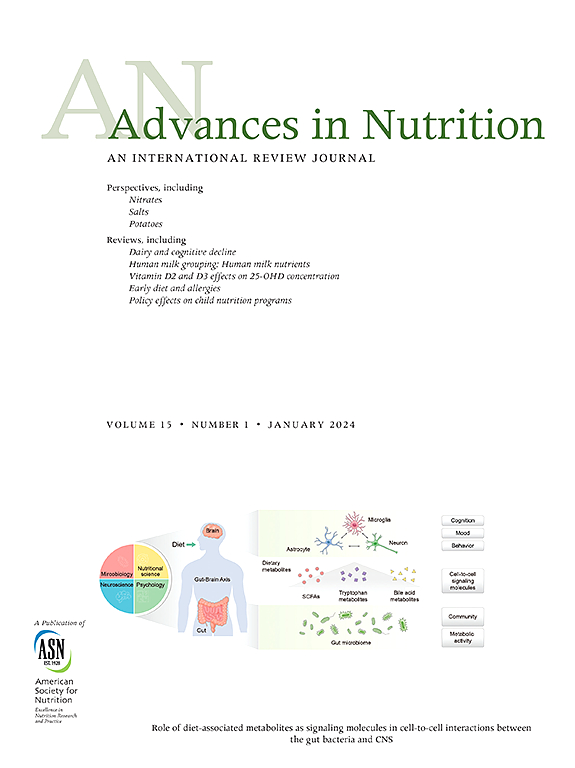Global Burden of Iodine Deficiency: Insights and Projections to 2050 Using XGBoost and SHAP
IF 9.2
1区 医学
Q1 NUTRITION & DIETETICS
引用次数: 0
Abstract
Iodine deficiency (ID) poses a significant global public health challenge. This study aimed to analyze trends from 1990 to 2021 and project future patterns ≤2050 using the extreme gradient boosting (XGBoost) model, with Shapley additive explanations (SHAP), to identify key factors and inform public health strategies. Data on ID from the Global Burden of Disease (GBD) 2021 study were used to model and predict its burden ≤2050 using XGBoost, with SHAP enhancing model interpretability. In 1990, global incident cases of ID were 7.51 million (age-standardized incidence rate [ASIR]: 126.11/100,000), rising to 8.08 million by 2021 (ASIR: 105.99/100,000, a 15.96% decrease), and projected to reach 8.48 million by 2050 (ASIR: 108.20/100,000). Prevalent cases increased from 146.42 million in 1990 (age-standardized prevalence rate [ASPR]: 2801.80/100,000) to 180.81 million in 2021 (ASPR: 2213.98/100,000, a 20.98% decrease), with 194.51 million expected by 2050 (ASPR: 1900.01/100,000). Disability-adjusted life years (DALYs) dropped from 2.46 million in 1990 (age-standardized disability-adjusted life year rate [ASDR]: 46.19/100,000) to 2.25 million in 2021 (ASDR: 27.67/100,000, a 40.10% decrease) but are projected to rise slightly to 2.51 million by 2050 (ASDR: 25.51/100,000). SHAP analysis identified iodized salt coverage as a key factor, with higher coverage levels associated with reduced ID burden in most countries. Women and people aged 10–30 y had higher incidence rates, although prevalence and DALYs peaked among those aged 20–45 y. Central and Eastern Sub-Saharan Africa and South Asia will continue to bear the highest burden through 2050. The XGBoost+SHAP model identified age, sex, and iodized salt coverage as key factors, with women and younger populations being high-risk groups. Strengthening iodization programs, improving health care access, targeted education, and consistent monitoring of vulnerable populations are essential to mitigate future risks and improve health outcomes.
全球碘缺乏负担:使用XGBoost和SHAP的见解和预测到2050年。
背景:碘缺乏症(ID)是一个重大的全球公共卫生挑战。本研究分析了1990年至2021年的趋势,并使用极端梯度增强(XGBoost)模型和SHapley加性解释(SHAP)预测了到2050年的未来模式,以确定关键因素并为公共卫生战略提供信息。方法:利用全球疾病负担(GBD) 2021研究中的ID数据,使用XGBoost建模并预测其到2050年的负担,SHAP增强了模型的可解释性。结果:1990年全球ID发病率为751万例(年龄标准化发病率ASIR: 126.11/10万),到2021年上升至808万例(ASIR: 105.99/10万,下降15.96%),预计到2050年将达到848万例(ASIR: 108.20/10万)。流行病例从1990年的14642万例(年龄标准化患病率,ASPR: 2801.80 /10万)增加到2021年的188081万例(ASPR: 2213.98 /10万,下降20.98%),到2050年预计为19451万例(ASPR: 1,900.01/10万)。伤残调整生命年(DALYs)从1990年的246万(ASDR: 46.19/10万)下降到2021年的225万(ASDR: 27.67/10万,下降40.10%),但预计到2050年将小幅上升到251万(ASDR: 25.51/10万)。SHAP分析确定,碘盐覆盖率是一个关键因素,在大多数国家,较高的覆盖率与减少碘盐负担有关。妇女和10-30岁的人发病率较高,而20-45岁的人患病率和DALYs最高。到2050年,撒哈拉以南非洲中部和东部以及南亚将继续承担最重的负担。结论:XGBoost + SHAP将年龄、性别和加碘盐覆盖率确定为关键因素,女性和年轻人群为高危人群。撒哈拉以南非洲中部和东部以及南亚将继续面临重大负担。加强碘化规划、改善医疗服务可及性、有针对性的教育和对弱势群体的持续监测对于减轻未来风险和改善健康结果至关重要。
本文章由计算机程序翻译,如有差异,请以英文原文为准。
求助全文
约1分钟内获得全文
求助全文
来源期刊

Advances in Nutrition
医学-营养学
CiteScore
17.40
自引率
2.20%
发文量
117
审稿时长
56 days
期刊介绍:
Advances in Nutrition (AN/Adv Nutr) publishes focused reviews on pivotal findings and recent research across all domains relevant to nutritional scientists and biomedical researchers. This encompasses nutrition-related research spanning biochemical, molecular, and genetic studies using experimental animal models, domestic animals, and human subjects. The journal also emphasizes clinical nutrition, epidemiology and public health, and nutrition education. Review articles concentrate on recent progress rather than broad historical developments.
In addition to review articles, AN includes Perspectives, Letters to the Editor, and supplements. Supplement proposals require pre-approval by the editor before submission. The journal features reports and position papers from the American Society for Nutrition, summaries of major government and foundation reports, and Nutrient Information briefs providing crucial details about dietary requirements, food sources, deficiencies, and other essential nutrient information. All submissions with scientific content undergo peer review by the Editors or their designees prior to acceptance for publication.
 求助内容:
求助内容: 应助结果提醒方式:
应助结果提醒方式:


